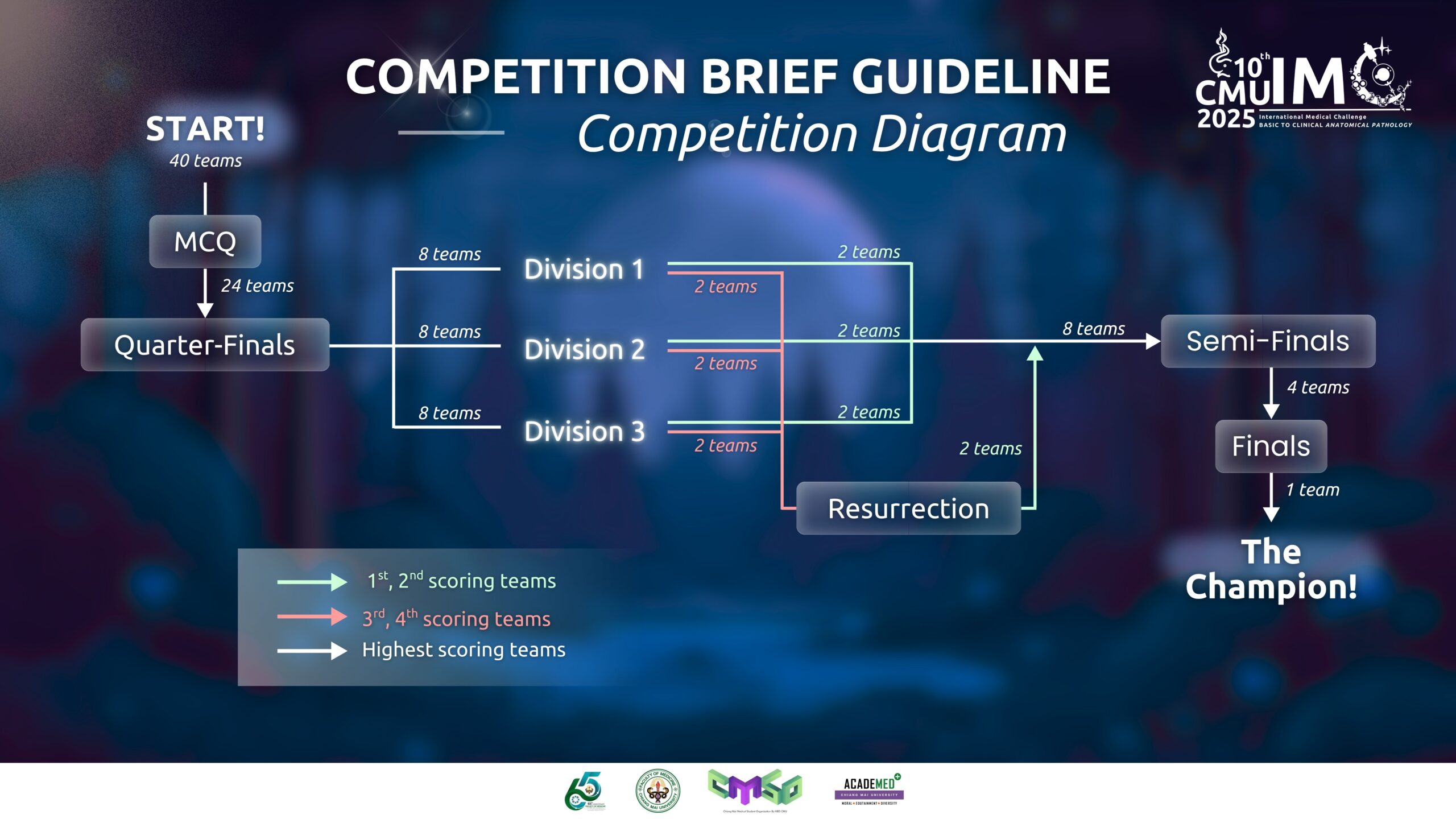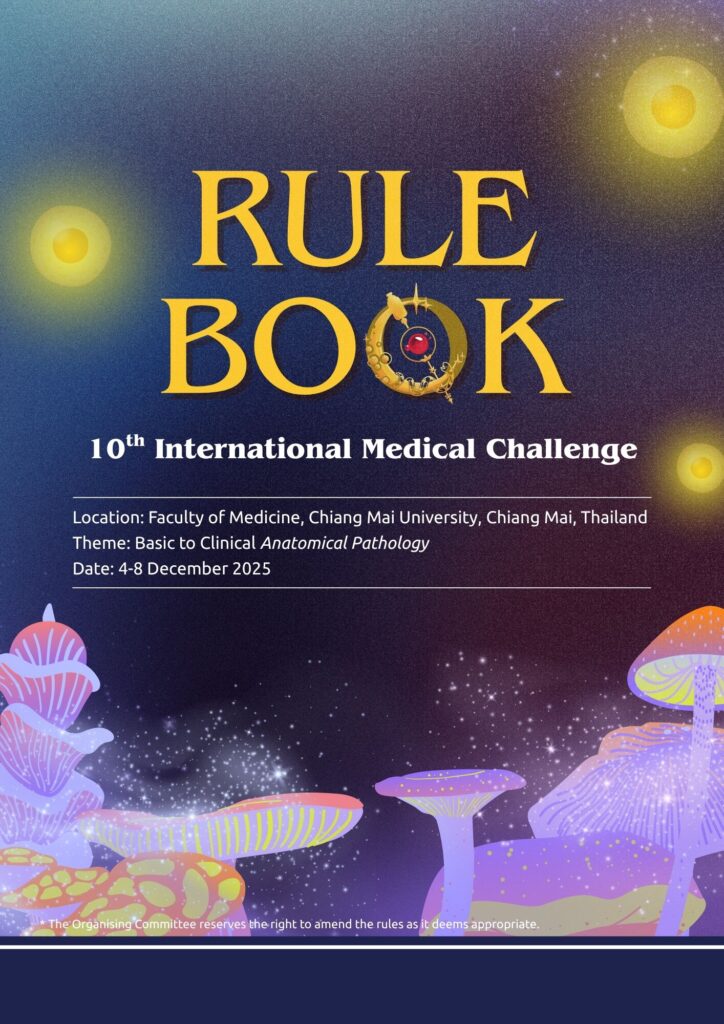
competition
There will be a total of 5 rounds in the competition, which are MCQ round, quarter-finals, resurrection, semi-finals, and finals
General Rules
Multiple-Choice Questions (MCQ) Round
Each team member will complete an individual multiple-choice examination, with each question worth 1 point. The 24 highest-scoring teams will advance to the Quarter-Finals.
Quater-Finals Round
This is a team challenge. The 24 qualified teams will be divided into 3 divisions, each consisting of 8 teams.
At the start of the challenge, each team will be given a set of 5 cards:
- 3 Basic cards
- 2 Advanced cards
The objective is for each team to use up all the given cards by correctly answering questions corresponding to the chosen difficulty level. In each round, teams will be presented with a randomised keyword or topic related to the problem set. The teams must then select a difficulty level (Basic or Advanced) and answer the corresponding short-answer questions. If a team answers correctly, the selected card will be used up and removed from their set. If a team answers incorrectly, the chosen card will be downgraded to the next lower difficulty level for the following round. At the end of the challenge, the top 2 teams from each division will advance to the Semi-Finals. Teams placing third and fourth will proceed to a Resurrection round, where they will have another opportunity to qualify for the Semi-Finals.
Resurrection Round
This is a team challenge. Each team will begin with 3 points. Before each question, teams must decide whether to place a bet or skip betting for that round. Following this, they will answer a short-answer question. A correct answer will earn the team 1 point plus twice the amount they wagered, while an incorrect response results in the loss of the wagered points for that round. It’s important to note that at the 6th round, 3 points will be deducted from each team’s total score before calculating the final rankings. At the end of the round, the 2 teams with the highest scores will advance to the Semi-Finals.
Semi-Finals Round
This is a team challenge. For each short-answer question, teams must select a difficulty level: easy, medium, or hard. Points will be awarded for each correct answer based on the chosen difficulty. Achieving consecutive correct answers at the same difficulty level will unlock special items that can aid teams in earning additional points. However, an incorrect answer to a medium or hard question will result in penalties. The 4 highest-scoring teams will advance to the Finals.
Finals Round
This is a team challenge. Teams will be presented with clinical cases along with physical examination findings. Teams must analyze the given information, along with laboratory results they’ve chosen to reveal, to answer questions based on their evaluation of each case. The team that performs best will be crowned the champion of CMU-IMC 2025.
Topic : Anatomical Pathology
Basic Pathology
1. The cell as a unit of health and disease
2. Cell injury, cell death, and adaptations
3. Inflammation and repair
4. Hemodynamic disorders, thromboembolic disease, and shock
5. Genetic disorders
6. Diseases of the immune system
7. Neoplasia
8. Environmental and nutritional diseases
9. Diseases of infancy and childhood
10. Surgical pathological technique; specimen processing; histochemical stains; immunohistochemical stains
Systemic Pathology
1. Pathology of blood vessel
2. Pathology of heart
3. Pathology of lymph nodes, spleen, thymus, and bone marrow
4. Pathology of lungs
5. Pathology of head and neck
6. Pathology of gastrointestinal tract
7. Pathology of liver and gallbladder
8. Pathology of pancreas
9. Pathology of kidney
10. Pathology of lower urinary tract and male genital system
11. Pathology of female genital tract
12. Pathology of breast
13. Pathology of endocrine system
14. Pathology of skin
15. Pathology of bones, joints including soft tissue tumors
16. Pathology of peripheral nerves and skeletal muscles
17. Pathology of central nervous system
18. Pathology of eyes
References Textbook
References for Anatomical Pathology (as specified by the CMU-IMC 2025 Competition Committee)
1. Vinay Kumar, Abul Abbas, Jon Aster. Robbins and Cotran. Pathologic basis of Disease, 10th ed. Philadelphia: Elsevier, 2020.
2. John Goldblum Laura Lamps Jesse McKenney Jeffrey Myers. Rosai and Ackerman’s Surgical Pathology, 11th ed. Philadelphia: Elsevier, 2018.
3. Christopher Fletcher. Diagnostic histopathology of tumors, 5th ed. Elsevier, 2021.
4. The WHO Classification of Tumours series. (Most updated edition, up to 2023)
5. The CAP Cancer Reporting Protocols. (https://www.cap.org/protocols-and-guidelines/cancer-reporting-tools/cancer-protocol-templates)
This year, cytology, autopsy, and forensic pathology are NOT included in the competition. All references used in the competition or appeal process must be those specified by the CMU-IMC 2025 Competition Committee only.

